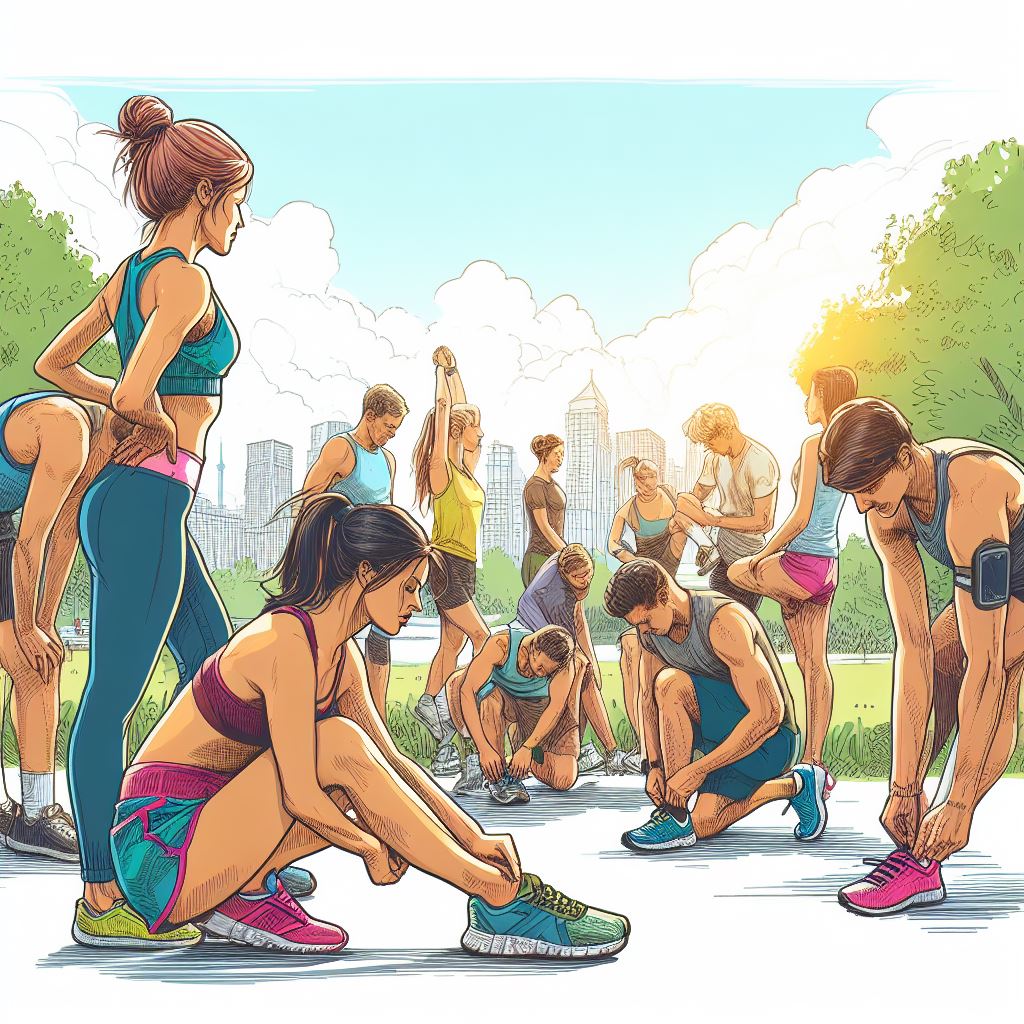Embarking on a fitness journey can be one of the most rewarding decisions you’ll make for your health and overall quality of life. Whether you’re looking to improve your physical strength, enhance your mental clarity, or just want to feel better in your daily life, starting with a solid foundation in physical fitness is key.
This guide is designed to walk you through the basics of physical fitness, tailored for beginners. It’s never too late or too early to start, and this journey is all about progressing at your own pace and celebrating your personal achievements.
Understanding Physical Fitness
Physical fitness isn’t just about lifting weights or running marathons; it’s a multifaceted concept that encompasses several key components. At its core, physical fitness involves a balance of strength, endurance, flexibility, and body composition.
Each component plays a crucial role in how effectively your body functions in daily activities and in combating health issues. Understanding these elements helps in crafting a fitness routine that is well-rounded and effective.
Strength training, for example, is not just for bodybuilders. It’s vital for maintaining muscle mass, supporting joint health, and improving metabolic rate. Endurance activities like walking, jogging, or cycling enhance cardiovascular health, boosting heart and lung function. Flexibility exercises, often overlooked, are essential for maintaining range of motion and preventing injuries. Lastly, a focus on body composition—understanding the balance of muscle, fat, and other tissues in your body—guides your nutritional choices and exercise routines.
The benefits of physical fitness extend far beyond the physical realm. Regular exercise has been shown to improve mental health, enhance mood, and boost cognitive functions. It’s a powerful tool in managing stress, anxiety, and even symptoms of depression.
Setting Realistic Fitness Goals
Goal setting is a critical step in your fitness journey. It’s essential to set realistic, achievable goals that motivate and guide you. Start by identifying what you want to achieve—be it weight loss, improved strength, better flexibility, or enhanced endurance. These goals should be specific, measurable, attainable, relevant, and time-bound (SMART).
Short-term goals provide immediate motivation and a sense of accomplishment. For example, aim to walk 30 minutes a day, five days a week, or attend two yoga classes per week.
Long-term goals are your ultimate aims, like running a 5K, achieving a certain body weight, or being able to perform a specific number of push-ups. Remember, goals evolve as you progress, so it’s okay to adjust them as you go along.
Creating Your Fitness Plan
Developing a fitness plan tailored to your goals and lifestyle is vital. Start by assessing your current fitness level and consider any health issues or physical limitations. Then, decide on the types of exercises that will help you reach your goals.
A balanced fitness plan should include a mix of cardiovascular (cardio) exercises, strength training, and flexibility workouts.
Cardio exercises like walking, jogging, or cycling are great for improving heart health and burning calories. Strength training, which can involve weights or bodyweight exercises, is crucial for building muscle and improving overall strength. Flexibility exercises, such as stretching and yoga, are essential for maintaining a good range of motion in your joints.
For beginners, it’s advisable to start slow and gradually increase the intensity and duration of your workouts. Consistency is key, so aim to exercise most days of the week, but also allow for rest days to let your body recover.

Essential Exercise Techniques for Beginners
Strength Training
Strength training is a cornerstone of fitness, essential for building muscle and improving metabolic health. Beginners should start with bodyweight exercises like squats, lunges, and push-ups, which can be done anywhere and don’t require equipment. Once comfortable, you can gradually incorporate weights or resistance bands. Focus on form and technique over quantity to avoid injury and maximize benefits.
Cardiovascular Exercises
Cardio exercises are crucial for heart health and burning calories. Start with low-impact activities like walking, swimming, or cycling. Aim for at least 150 minutes of moderate-intensity cardio per week, as recommended by health experts. As your endurance improves, you can increase the intensity or duration of your cardio sessions.
Flexibility and Mobility
Flexibility and mobility exercises are often neglected but are vital for a well-rounded fitness routine. Incorporate stretching into your routine, focusing on major muscle groups. Yoga or Pilates can also be excellent ways to improve flexibility and core strength. These practices not only enhance physical performance but also aid in recovery and injury prevention.
Nutrition and Fitness
A crucial aspect of any fitness routine is nutrition. What you eat plays a significant role in fueling your workouts and achieving your fitness goals. A balanced diet rich in nutrients is key.
This includes a mix of proteins for muscle repair, carbohydrates for energy, and healthy fats for joint health and overall wellbeing. Hydration is equally important; drinking adequate water before, during, and after exercise is essential for optimal performance and recovery.
For beginners, understanding the basics of nutrition doesn’t require a complete diet overhaul. Start by incorporating more whole foods like fruits, vegetables, lean proteins, and whole grains into your meals. Pay attention to portion sizes and try to limit processed foods, sugars, and excessive fats. Remember, nutrition is not one-size-fits-all; it’s about finding what works best for your body and your fitness goals.
Integrating Fitness into Your Daily Routine
Incorporating fitness into a busy schedule can be challenging, but it’s essential for consistent progress. Start by identifying pockets of time in your day that can be dedicated to physical activity. This could be a morning jog, a walk during your lunch break, or a quick workout session in the evening. Breaking up your exercise into shorter, more manageable sessions can be just as effective as one long workout.
Additionally, consider ways to be more active in your daily life outside of designated exercise times. Take the stairs instead of the elevator, walk or bike to nearby destinations, or do some light stretching while watching TV. Every bit of activity adds up and contributes to your overall fitness and health.
Overcoming Common Challenges
Staying committed to a fitness routine can be tough, especially when faced with challenges like lack of motivation, time constraints, or hitting a plateau. To overcome these hurdles, it’s important to keep your goals in mind and remember why you started.
Changing up your routine can help keep things interesting and prevent boredom. If you’re struggling with motivation, consider finding a workout buddy or joining a fitness community, either in person or online.
When you hit a plateau, it’s a sign that your body has adapted to your current routine. This is a normal part of the fitness journey. To continue making progress, try increasing the intensity of your workouts, adding new exercises, or altering your nutrition plan. Remember, setbacks are a natural part of the process. The key is to stay resilient and keep moving forward.
Tracking Your Progress
Monitoring your fitness progress is essential for staying motivated and adjusting your routine as needed. This can be as simple as keeping a workout journal, tracking your exercise and dietary habits, or using fitness apps. Pay attention to how your body feels, how your clothes fit, or changes in your energy levels—these are all indicators of progress.
Tracking isn’t just about measuring physical changes. It’s also about acknowledging the effort you’re putting in and celebrating small victories along the way. Whether it’s being able to jog for a longer duration, lifting heavier weights, or feeling more energetic, each achievement is a step towards your overall fitness goals.
Safety and Injury Prevention
As you embark on your fitness journey, it’s crucial to exercise safely to prevent injuries. This means understanding proper exercise techniques and listening to your body. If you’re new to exercise or have any pre-existing health conditions, consider consulting a fitness professional or physical therapist for guidance.
Warm-ups and cool-downs are vital parts of any workout routine. A proper warm-up prepares your body for exercise and reduces the risk of injury, while cooling down helps your body recover and adjust after a workout. It’s also important to recognize the difference between normal muscle soreness and pain. If you experience sharp or persistent pain, it’s time to rest and seek medical advice if necessary.
Finding Support and Community
Embarking on a fitness journey can be daunting, but you don’t have to do it alone. Finding a support system or joining a fitness community can provide motivation, accountability, and encouragement. This could be a local gym, a running club, or online forums and social media groups. Sharing your experiences, challenges, and successes with others who have similar goals can be incredibly rewarding and inspiring.
A supportive environment not only helps you stay on track but also provides a platform for learning and growth. You can exchange tips, celebrate each other’s achievements, and even find new workout buddies. Remember, everyone’s fitness journey is unique, but having a supportive community can make the journey more enjoyable and sustainable.
It’s about finding balance, setting achievable goals, and enjoying the process. Remember, fitness is a personal journey, and progress, not perfection, is what counts. Take the first step, stay consistent, and embrace the transformative power of physical fitness in your life.















